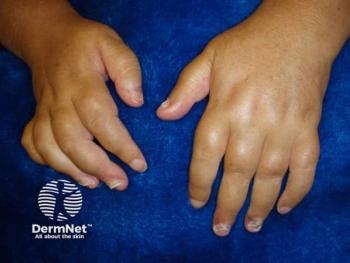
Importance of Determining GPP Event Trigger
Erin Boh, MD, discusses the role of steroid administration and withdrawal as a trigger for GPP, highlighting the importance of physician awareness of external influences initiating this condition.
Episodes in this series

Erin Boh, MD: It is important to find the trigger because when it’s steroids, sometimes putting the patient back on that trigger—which sounds rather paradoxical—might be the best thing to do. Then slowly taper them down and off as you get them on the drug of choice, which is this now FDA-approved therapy for pustular psoriasis. I do think that rapid withdrawal is just hard to manage.
Mark Lebwohl, MD: Now that you’ve told this story, I’m going to use it. I don’t know what the percentage of death is. I’m sure if you go up on prednisone by 10 mg, you are increasing the danger to a patient’s life. There have been a couple very recent publications on the use of systemic steroids—not in psoriasis, where I think you shouldn’t use systemic steroids, but in general. The equivalent of a Medrol [methylprednisolone] dose pack where you go down from 30 to 0 mg over 6 days was associated with something like a 3-fold increase in venous thromboembolism, a doubling of sepsis, and a doubling of bone fracture in the ensuing 30 to 90 days. That is published, so there’s no question we’re dramatically increasing the complications for patients. If you want to say to an insurance company, “We just put the patient on 60 mg of prednisone and his mortality is 55%,” then go for it.
Erin Boh, MD: Are they going to check Mark Lebwohl? I figured not.
Mark Lebwohl, MD: You blame me. You have my permission to blame me.
Erin Boh, MD: I’mjust joking. But that brings us to another good point, which is that some patients will just flare with pustular psoriasis, but there are triggers other than steroids. Steroids are the very biggest trigger, but sometimes infections can do it. In my patient, one of the confounders was she had just gotten the COVID-19 vaccine at the same time as the Pneumovax 23 [Pneumococcal Vaccine Polyvalent]. When you think about, especially the COVID-19 vaccine being in part mediated by T cells, we do see a lot of immune dysfunction and dysregulation transiently after these infections. And when she got this “rash” after her COVID-19 vaccine, that’s when the primary care doctor gave her steroids. There were several confounders that could have triggered her GPP [generalized pustular psoriasis]; infection being one and steroids being the other. I’m not so sure the vaccines played any role in it whatsoever, but it certainly did confound our issue.
The other issue was that one of our biopsies ultimately showed this OID [orbital inflammatory disease] infiltrate with EOS [eosinophil count]. So then we’re going down a different road, like of a drug rash, and you’re thinking, “Oh my gosh, she can’t have 4 different potential etiologies for this trigger.” So she was all over the place. Maybe that’s where your biopsies will do you some harm and not so much good, because her first biopsy in the emergency department showed an OID infiltrate with vasculitis. Of course, then I’m thinking, “This is not vasculitis, she’s got pustules head to toe.” So, it was a bit of a confounder.
Mark Lebwohl, MD: In what you just said, there are several things that came to mind. First, we published a series of patients whose psoriasis got worse after the COVID-19 vaccine, but I agree with your assumption that the prednisone is what triggered it, and that’s the most common trigger. A biopsy is fraught with difficulty. In fact, if somebody comes in with a specific clinical presentation, such as your patient who was covered with pustules and had a history of psoriasis, and the pathologist says it’s a vasculitis. A vasculitis is characterized by infiltrator polys that break up, and I know that diagnosis was just confirmed by the pathologist, and it is GPP.
It’s the same thing as when a patient comes in with a diagnosis and the pathologist reads it as a vasculitis and it’s a classic Sweet syndrome, or pyoderma gangrenosum. All those polymorphonuclear leukocyte infiltration diseases can, to a pathologist, look the same. You really need clinical context to make the right diagnosis. So, the biopsy is not the final arbiter, it’s the clinician.
Transcript Edited for Clarity
Newsletter
Like what you’re reading? Subscribe to Dermatology Times for weekly updates on therapies, innovations, and real-world practice tips.























